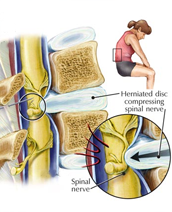Selective Nerve Root Block

In an SNRB, the nerve is approached at the level where it exits the foramen (the hole between the vertebral bodies). The injection is done both with a steroid (an anti-inflammatory medication) and lidocaine (a numbing agent). Fluoroscopy (live X-ray) is used to ensure the medication is delivered to the correct location. If the patient’s pain goes away after the injection, it can be inferred that the back pain generator is the specific nerve root that has just been injected. Following the injection, the steroid also helps reduce inflammation around the nerve root.
Success rates vary depending on the primary diagnosis and whether or not the injections are being used primarily for diagnosis. While there is no definitive research to dictate the frequency of SNRBs, it is generally considered reasonable to limit SNRBs to three times per year.
Technically, SNRB injections are more difficult to perform than epidural steroid injections and should be performed by experienced physicians. Since the injection is outside the spine, there is no risk of a wet tap (cerebrospinal fluid leak). However, since the injection is right next to the nerve root, sometimes an SNRB will temporarily worsen the patient’s leg pain.

